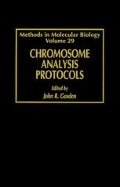Abstract
Telomeres are the specialized structures that define chromosome ends and have been the subject of several recent reviews (1–5). Telomeres allow a linear replication unit to be maintained as a linear molecule and overcome the end replication problem. The telomere must also distinguish a bona fide chromosome end from ends derived from an interstitial chromosome break, since broken chromosome ends are unstable. Most telomeres isolated to date are composed of tandem repetitive sequence arrays that are generally rich in T and G residues, for example, the vertebrate repeat is (TTAGGG)n(6) and that of many plants appears to be (TTTAGGG)n(7). Telomeres are synthesized by telomerase, identified in ciliates and mammalian cells, which adds on additional terminal repeats to a preexisting telomere (reviewed in 2–5). It is these repetitive sequences that form a functional telomere.
Access this chapter
Tax calculation will be finalised at checkout
Purchases are for personal use only
References
Blackburn, E H and Szostak, J W (1984) The molecular structure of centromeres and telomeres. Ann Rev Biochem. 53, 163–194.
Zakian, V. A (1989) Structure and function of telomeres Ann. Rev. Genet 23, 579–604.
Greider, C W, (1990) Telomeres, telomerase and senescence BioEssays 12, 363–369
Greider, C W (1991) Telomeres Curr Opinion Cell Biol 3, 444–451.
Blackburn, E. H (1991) Structure and function of telomeres Nature 350, 569–573
Meyne, J., Ratliff, R L, and Moyzis, R. K. (1989) Conservation of the human telomere sequence (TTAGGG)n among vertebrates Proc. Natl Acad. Sci USA 86, 7049–7053.
Richards, E J and Ausubel, F M. (1988) Isolation of a higher eukaryotic telomere from Arabidopsis thaliana. Cell 53, 127–136.
de Lange, T, Shiue, L., Myers, R M, Cox, D R, Naylor, S L, Killery, A M, and Varmus, H. E (1990) Structure and variability of human chromosome ends. Mol Cell Biol 10, 518–527
Shampay, J., Szostak, J. W., and Blackburn, E. H. (1984) DNA sequences of telomeres maintained in yeast. Nature 310, 154–157.
Burke, D T., Carle, G F, and Olson, M. V (1987) Cloning of segments of exogenous DNA into yeast by means of artificial chromosome vectors. Science 236, 806–812.
Cross, S. H., Allshire, R. C, McKay, S. J, McGill, N. I., and Cooke, H J. (1989) Cloning of human telomeres by complementation m yeast. Nature 338, 771–774
Brown, W. R. A. (1988) Molecular cloning of human telomeres in yeast. Nature 338, 774–776
Reithman, H. C, Moyzis, R. K, Meyne, J, Burke, D T., and Olson, M V (1989) Cloning human telomeric DNA fragments into Saccharomyces cerevisiae using a yeast-artificial-chromosome vector Proc. Natl Acad. Sci USA 86, 6240–6244.
Cheng, J-F, Smith, C L, and Cantor, C. R. (1989) Isolation and characterization of a human telomere. Nucleic Acids Res. 17, 6109–6127.
Bates, G P., MacDonald, M. E, Baxendale, S., Sedlacek, Z, Youngman, S, Romano, D, Whaley, W. L, Allitto, B A., Poustka, A., Gusella, J. F., and Lehrach, H (1990) A yeast artificial chromosome telomere clone spanning a possible location of the Huntingdon disease gene Am J Hum Genet. 46, 762–775
Sambrook, J., Fritsch, E F, and Maniatis, T (1989) Molecular Cloning-A Laboratory Manual, 2nd ed. Cold Spring Harbor Laboratory, Cold Spring Harbor, NY
Burgers, P. M J and Percival, K. J. (1987) Transformation of yeast sphero-plasts without cell fusion Anal Biochem 163, 391–397
McCormick, M. K., Shero, J. H., Connelly, C. J., Antonarakis, S. E., and Hieter, P. A. (1990) Methods for cloning large segments as artificial chromosomes in S cervisiae. Technique 2, 65–71
Allshire, R. C (1990) Introduction of large linear mimchromosomes into Schizosaccharomyces pombe by an improved transformation procedure Proc. Natl. Acad Sci USA 87, 4043–40
Author information
Authors and Affiliations
Editor information
Editors and Affiliations
Rights and permissions
Copyright information
© 1994 Humana Press Inc, Totowa, NJ
About this protocol
Cite this protocol
Allshire, R.C., Cooke, H.J. (1994). Chromosome Substructure Investigation. In: Gosden, J.R. (eds) Chromosome Analysis Protocols. Methods in Molecular Biology™, vol 29. Humana Press. https://doi.org/10.1385/0-89603-289-2:493
Download citation
DOI: https://doi.org/10.1385/0-89603-289-2:493
Publisher Name: Humana Press
Print ISBN: 978-0-89603-289-7
Online ISBN: 978-1-59259-516-7
eBook Packages: Springer Protocols

